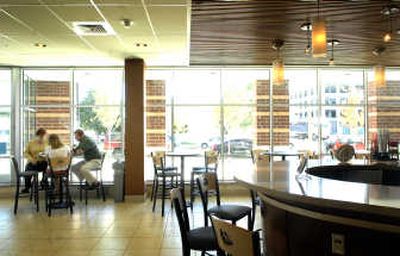GU students return to new digs

It’s a scenario that a lot of parents with children away at college likely have experienced. A student visits her family after a few months away, and it slips. At the dinner table, she refers to campus as “home,” as opposed to the place she was reared for the last 18 years.
It might be hard for Mom and Dad to hear, but that’s exactly what Dennis Colestock, director of housing and residential life at Gonzaga University, wants to have happen. Part of his job is to foster relationships among students, and often those friendships are made in the places where people live.
“The residence hall experience puts people into a community with each other, and people will build that community,” he says. “I like to build facilities that invite that.”
Now – a year later than originally planned – Gonzaga has a new facility for students to call home. More than 200 students have moved into the Kennedy Apartment complex, which burned to the ground in March 2006 while under construction and was rebuilt during the last year.
Despite the near-total loss 17 months ago, the university never strayed from its original plans for the buildings.
“We thought we had it right the first time, so we did it again,” university spokesman Dale Goodwin says.
In many ways, the Kennedy Apartments stand out from other types of college housing. For one, the building’s modern design contrasts with the more stately buildings on Gonzaga’s campus. The college community had selected the design, by ALSC Architects PS, among other options because the look helped linked the university’s western edge, on Ruby Street, with Spokane’s urban core just across the Spokane River, Goodwin says.
“They designed it to be contemporary urban styling, to fit in with the downtown flow and the urban housing trend going on in downtown Spokane now,” he says.
The apartments enable juniors, seniors and graduate students to stay on campus and take part in traditional college activities, such as attending basketball games, without the inconvenience of having to get in the car.
“It used to be that after sophomore year, students would scatter to find housing off campus,” Goodwin says. “Now, more … students don’t want to leave after their sophomore year.”
Most apartments within the U-shaped complex have three bedrooms, two bathrooms, a kitchen, and living room, giving upperclassmen more privacy than they had in residence halls. Yet, down the hallways and on the building’s main floor, there are places where students can congregate, including a Bulldog apparel store and a bistro.
On each floor there are recreation areas with televisions, ping-pong tables, and places to play chess. The complex also has a sundeck overlooking downtown and a lounge with a grand piano.
“There’s a lot of common space to build that community, that ‘home,’ if you will,” Colestock says.
Moving in
The Kennedy apartments are large and bright. Some have vaulted ceilings and skylights, and each comes with mission-style furniture, including cedar-lined dressers in the bedrooms.
“This is better than any place I ever lived in,” said Jerry Wechsler, taking a break from moving in his daughter, Amy, on the last Sunday in August.
The Wechslers were surprised to find a full kitchen in Amy’s apartment – they’d expected just a small refrigerator and microwave – so they made an extra trip to the store to buy pots and pans.
Maureen Keegan, 20, decorated her apartment’s kitchen with photos of food she’d clipped out of a calendar and laminated. In her bedroom, she hung art prints and draped a gauzy pink curtain over the window, giving the room a soft glow.
Other residents personalized their spaces with doormats, Tibetan peace flags, and a pet fish named “Fish.”
Senior Tebria Stone said she was going for an “old-fashioned” look in her apartment by covering her bed in a quilt she inherited from her great-grandmother.
Stone, like many residents, had planned to move into Kennedy a year ago, before the fire forced her to scramble for other housing.
“It was a growing experience because I had to go out and find my own place,” she says.
Stone prefers Kennedy over her last apartment because it’s on campus yet far enough away from school’s main buildings to make you “feel like you’re growing up.”
Already there were signs of that sense of community Colestock hopes to build. On move-in day, posters announced the upcoming birthdays of residents and students completed get-to-know-you questionnaires in the bistro.
As one would expect, the scene at the complex in late August was more jubilant than the mood on campus March 14, 2006, the morning after the blaze. The apartments had been a few months away from completion when the fire broke out just after midnight.
Colestock, who lives on campus, arrived on the scene even before the fire crews did.
“When I first saw it, I knew it was an absolute, complete loss,” he recalls.
Investigators determined the blaze had been set intentionally, but they never figured out who did it.
Reconstruction began in late April 2006, after structural engineers ensured the safety of the building’s concrete foundation. Salvaging that saved the general contractor, Walker Construction Inc., six weeks of work, Goodwin says.
The fire was a thing of the past last week, though, as students loaded the elevators with the necessities, including bundles of clothing, raw chicken, toilet paper and a self-described “exhausted parent who will be heading to the nearest bar to get rehydrated.”
The worn-out dad then received suggestions from students on the best watering holes to visit.